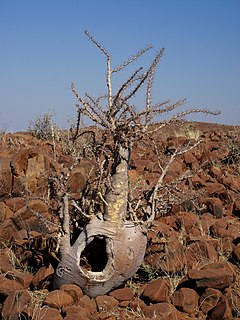
Apocynaceae is a family of flowering plants that includes trees, shrubs, herbs, stem succulents, and vines, commonly known as the dogbane family, because some taxa were used as dog poison. Members of the family are native to the European, Asian, African, Australian, and American tropics or subtropics, with some temperate members. The former family Asclepiadaceae is considered a subfamily of Apocynaceae and contains 348 genera. A list of Apocynaceae genera may be found here.

Pachypodium is a genus of succulent spine-bearing trees and shrubs, native to Madagascar and Africa. It belongs to the family Apocynaceae.

Pachypodium lealii, the bottle tree, is a species of plant included in the genusPachypodium. The scientific name derives from the 19th century Portuguese geologist Fernando da Costa Leal, who described the bottle tree during an exploration in southern Angola.

Pachypodium lamerei is a species of flowering plant in the family Apocynaceae. It is a stem succulent, photosynthesizing mainly through its trunk, and comes from the island of Madagascar, off the east coast of Africa. It has large thorns and leaves mostly just at the top of the plant, and large, fragrant flowers. The species has become one of the best known pachypodiums in cultivation, being relatively easy to propagate and grow. In cultivation it is often marketed as the Madagascar palm, despite its not being a palm at all. A variety called "Ramosum" has been described. It is distinguished mostly by a dwarf growth habit.

Friedrich Martin Josef Welwitsch was an Austrian explorer and botanist who in Angola discovered the plant Welwitschia mirabilis. His report received wide attention among the botanists and general public, comparable only to the discovery of two other plants in the 19th century, namely Victoria amazonica and Rafflesia arnoldii.
Plants belonging to the genus Pachypodium vary widely from each other in some aspects, but also share a number of basic common traits. Each species is adapted to the specific environment which it inhabits, but all species of the genus share certain anatomical and metabolic traits, reflecting their common evolutionary ancestry.
The taxonomy of the Pachypodium genus is the study of the species and subspecies in the genus Pachypodium. There are currently 25 recognized species in the genus, of which 17 are shrubs and eight are trees.

Pachypodium ambongense is a species of plant in the family Apocynaceae. It was first published as a species of the genus Pachypodium in 1924 by the botanist Henri Louis Poisson.

Pachypodium baronii, the Madagascar palm or bontaka, is a flowering plant in the family Apocynaceae. It has the habit of a robust shrub with a spherical or bottle-shaped trunk. It has several cylindrical branches at the top.
Pachypodium bicolor is a species of plant in the family Apocynaceae.
Pachypodium habitats consist of isolated, specialized, micro–environmental niches, generally xeric, rocky, frost-free areas within parts of western Madagascar and southern Africa. Pachypodium species are often indifferent to the regional ecological, biotic zone of vegetation, a fact which explains some of Pachypodium morphology and architecture. The large scale vegetation zones are in some cases irrelevant to the micro-environments of Pachypodium, in the sense that the xeric niches may be embedded in larger mesic biomes.

Pachypodium brevicaule is a species of plant that belongs to the family Apocynaceae.

Operculicarya decaryi, known as elephant tree or jabily, is a thick stemmed succulent plant species in the family Anacardiaceae, named after the botanical collector Raymond Decary. It is found in Madagascar and is also grown as a bonsai tree.

Pachypodium rutenbergianum is a species of Pachypodium native to Madagascar. The plant can reach 3 to 8 m high, and its trunk up to 60 cm in diameter at base. The plant has short branches and 1-cm long spines. Leaves are green and 10 to 15 cm long, 4 cm wide. Its flowers are white.

Dypsis decaryi is a species of flowering plant in the Arecaceae family. It is commonly known as the triangle palm. It is indigenous to the Madagascan rainforest. Some specimens grow to a height of some 15 metres (49 ft) in the wild. It is relatively new to cultivation however, so outside its native habitat it rarely achieves anything like that height. The leaves are about 2.5 metres in length, growing almost upright from the trunk and arching gracefully outward about a metre from their tips. The leaf bases are arranged in three vertical columns set about 120 degrees apart on the main stem, forming a triangular shape in cross section. This shape has given rise to the palm's common name.

Pachypodium namaquanum, also known as halfmens or elephants trunk, is a succulent plant of Southern Africa. The genus name Pachypodium is from the Greek for 'thick foot', an allusion to its swollen base, while the species name namaquanum is a reference to Namaqualand.

Brookesia decaryi is a species of chameleon, which is endemic to Madagascar, and is ranked as an endangered species by the International Union for Conservation of Nature (IUCN). It was initially described in 1939 by Fernand Angel. B. decaryi is commonly known as Decary's leaf chameleon, spiny leaf chameleon, or Decary's pygmy chameleon.

Pachypodium densiflorum is a species of flowering plant in the Apocynaceae family. It is native to Madagascar. In habitat, it grows on granite rocks in the central plateau of Madagascar.

Pachypodium succulentum is a member of the family Apocynaceae native to the Cape Provinces and the Free State province of South Africa.

Pachypodium bispinosum is a succulent sub-shrub in the family Apocynaceae
















